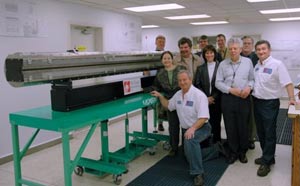
Handy Links
SLAC News Center
SLAC Today
- Subscribe
- Archives: Feb 2006-May 20, 2011
- Archives: May 23, 2011 and later
- Submit Feedback or Story Ideas
- About SLAC Today
SLAC News
Lab News
- Interactions
- Lightsources.org
- ILC NewsLine
- Int'l Science Grid This Week
- Fermilab Today
- Berkeley Lab News
- @brookhaven TODAY
- DOE Pulse
- CERN Courier
- DESY inForm
- US / LHC
SLAC Links
- Emergency
- Safety
- Policy Repository
- Site Entry Form

- Site Maps
- M & O Review
- Computing Status & Calendar
- SLAC Colloquium
- SLACspeak
- SLACspace
- SLAC Logo
- Café Menu
- Flea Market
- Web E-mail
- Marguerite Shuttle
- Discount Commuter Passes
-
Award Reporting Form
- SPIRES
- SciDoc
- Activity Groups
- Library
Stanford
Around the Bay
LCLS Undulator System Hits Milestone at Argonne
 The LCLS Projectís first production undulator magnet arrived at Argonne National Laboratory (ANL)
last week.
The LCLS Projectís first production undulator magnet arrived at Argonne National Laboratory (ANL)
last week.
Undulators are the heart of the LCLS free electron laser (FEL). They are comprised of alternating permanent magnet blocks made of neodymium-iron-boron and vanadium permendur poles. The magnets and poles are mounted in precision aluminum structures and clamped into a massive 3.4-meter-long titanium strongback, a casing that secures the cylinder in the right position and counteracts the very high magnetic forces between the upper and lower magnetic arrays.
"The undulator magnetic fields and the electron beam are what make the free electron laser work," said Stephen Milton, LCLS project director at ANL. "They are the essence of the FEL."
As the high-energy electrons traverse the undulators, they are accelerated back and forth, causing them to emit a very intense x-ray beam. These x-rays will allow scientists to study, among other things, nanoscopic, ultrafast chemical and atomic processes. ANL has been entrusted to design and oversee the construction of the entire LCLS undulator system, including magnets, support structures, diagnostics, controls and the vacuum system.
Eventually, 33 of these magnets will be linked together to make an undulator system about one and a half football fields long, the longest undulator magnet system in the world.
Engineers face the challenge of ensuring that the undulator system is extremely accurate and stable. Their design achieves an accurate, constant field that can be maintained over the next two decades. Though the undulator system is being designed by ANL, the magnets will be assembled by two precision machine shops, Hi-Tech Manufacturing in Illinois and Metalex Manufacturing, Inc. in Ohio.
—Juhi YajnikSLAC Today, March 21, 2006